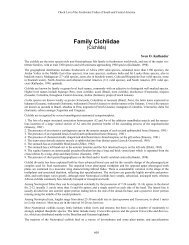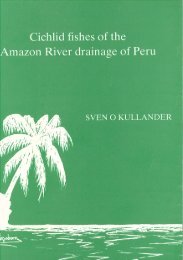Open Access PDF - Sven Kullander
Open Access PDF - Sven Kullander
Open Access PDF - Sven Kullander
Create successful ePaper yourself
Turn your PDF publications into a flip-book with our unique Google optimized e-Paper software.
(<strong>Kullander</strong> & Nijssen, fig. 10). Cichla orinocensis<br />
and C. mirianae are unique in possessing a series<br />
of three distinct ocellated blotches along the middle<br />
of the side, formed directly from the juvenile<br />
lateral blotches. In C. mirianae the blotches are<br />
mediated by the lateral band whereas in C. orinocensis<br />
they are usually separate. In C. intermedia<br />
minute ocellated blotches may develop in several<br />
of the vertical bars, and are mediated by the<br />
irregular lateral band. No adult breeding males<br />
have been available of C. melaniae, but it seems<br />
that in this species sides are sprinkled with ocellated<br />
spots, and the vertical bars are deep black<br />
and narrow (Fig. 48). Cichla jariina, C. pinima,<br />
C. thyrorus, and C. vazzoleri possess ocellated<br />
blotches tracing portions of the precursory vertical<br />
bars (Figs. 58-59, 63, 69-72, 78-79). In C. temensis,<br />
vertical bars remain wide and distinctive but<br />
are not, or only narrowly margined with light.<br />
Species of Cichla differ in the number of vertical<br />
bars on the side. Three principal dark bars in<br />
homologous position occur in all species, and less<br />
intensely pigmented dark bars appear between<br />
the principal bars in C. melaniae, C. nigromaculata,<br />
C. ocellaris, and C. piquiti. The observational basis<br />
for this character state is somewhat weak in<br />
C. melaniae, based on one preserved specimen and<br />
photographs. Cichla intermedia, C. pleiozona, and<br />
individuals of other species frequently possess a<br />
bar anteriorly on the caudal peduncle. In C. intermedia<br />
with typically six bars, the bars are<br />
somewhat irregularly arranged and there may be<br />
additional bars. The pattern of three prominent<br />
dark markings on the side (blotches in juveniles,<br />
bars in adults) is highly unusual among cichlids,<br />
which typically possess several vertical dark bars<br />
and a dark blotch approximately at the middle<br />
of the side. Among Neotropical cichlids, only<br />
Satanoperca daemon (two blotches) and S. acuticeps<br />
(three blotches) stand out having more than one<br />
prominent, more or less ocellated blotch on the<br />
side. Adults of Boulengerochromis microlepis, a large<br />
cichlid species in Lake Tanganyika, possesses<br />
three large blotches along the middle of the side.<br />
Among riverine African cichlids the larger species<br />
of Hemichromis and the large tilapia species<br />
Oreochromis andersonii also possess three large<br />
midlateral blotches. All these species have multiple<br />
vertical bars. Many other cichlids possess a<br />
series of dark blotches along the side, in the position<br />
of vertical bars.<br />
Cichla is apparently unique in starting in<br />
early ontogeny with two to three midlateral<br />
Ichthyol. Explor. Freshwaters, Vol. 17, No. 4<br />
389<br />
blotches, and developing a barred state later in<br />
ontogeny. Very small specimens of Cichla have<br />
not been available. The smallest specimens reliably<br />
identified are 16 mm SL and already well<br />
past the larval stage. Free swimming Cichlasoma<br />
dimerus, a cichlasomatine South American cichlid,<br />
possess pigment patches gradually developing<br />
into vertical bars already at about 5 mm length<br />
(Meijide & Guerrero, 2000). The lateral blotches<br />
in juvenile Cichla may correspond positionally to<br />
the bar immediately posterior to the pectoral fin<br />
(bar 1) and above the anal fin (bar 3) in C. dimerus<br />
(Meijide & Guerrero, 2000: fig 8b), corresponding<br />
to bars 6 and 4-5 respectively in Cichlasoma amazonarum<br />
in <strong>Kullander</strong> (1983: fig. 4). It is not clear<br />
if the midlateral blotch in those cichlasomatine<br />
cichlids (bar 6 in <strong>Kullander</strong>, 2003: fig. 4) is a portion<br />
of the anterior juvenile bar (bar 7) or an independent<br />
pigment patch, but could correspond<br />
to the middle blotch/bar (bar 2) in Cichla.<br />
Further study is needed to investigate the<br />
homology of colour markings in cichlids including<br />
Cichla, but the preliminary comparison suggests<br />
that the blotches and bars in Cichla may be<br />
homologous with elements in other Neotropical<br />
cichlids in which juvenile vertical markings are<br />
variously split, resulting in a basic pattern of 8<br />
serially homologous dark bars in the adults of the<br />
majority of species (<strong>Kullander</strong> & Silfvergrip, 1991:<br />
412). In the multibarred Cichla species, viz. C. intermedia,<br />
C. nigromaculata, C. ocellaris, C. piquiti,<br />
and to some extent C. melaniae, caudal peduncle<br />
bars cannot be observed, but taking the bar above<br />
the anal fin as fixed common homologue, the five<br />
bars below the dorsal fin correspond to bars 2-8<br />
(4-5 being a divided bar) in the scheme of <strong>Kullander</strong><br />
(1983) and 3-7 in that of <strong>Kullander</strong> & Silfvergrip<br />
(1991). Bar 8 in <strong>Kullander</strong> & Silfvergrip<br />
(1991) is a dark marking anterior to the dorsal fin,<br />
which is usually indistinct in Cichla. The caudal<br />
blotch in most Neotropical cichlids forms as a<br />
vertical marking and gradually becomes a dorsal<br />
blotch (<strong>Kullander</strong>, 1983: fig. 7), but in Cichla and<br />
Crenicichla it starts as a somewhat elongate midbasal<br />
blotch continuous with the lateral band, and<br />
the blotch ends up in adults in a slightly more<br />
dorsal position as an effect of relative growth of<br />
adjacent areas. In Crenicichla the caudal ocellus is<br />
formed already at 20-25 mm SL.<br />
The species most similar to other cichlids with<br />
regard to bar development is C. intermedia in<br />
which the typically six bars are relatively similar<br />
in width and intensity. Small juveniles have not




